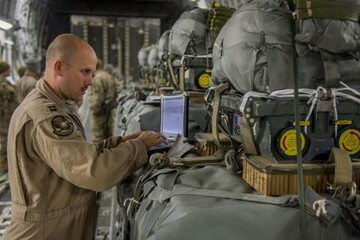Faster, Smarter, Safer: Improving Aerial Resupply with Airdrops
CAMBRIDGE, MA – Airdrop has long proved a cornerstone of military and humanitarian missions as a way to deliver food and supplies to areas inaccessible to vehicle convoys. Precision, however, isn’t easy when delivering supplies from 25,000 feet above sea level and 10 or more miles away from the desired drop zone. A re-supply parachute that strays off course can result in lost supplies, property damage, human casualties and the real possibility of increased risk for those recovering the supplies.
Draper is working with the U.S. Army Natick Soldier Research, Development and Engineering Center (NSRDEC) to address these challenges—and improve airdrop precision—by focusing on the most challenging aspects of aerial resupply guidance, navigation and control. In a series of papers presented at a recent conference of the American Institute of Aeronautics and Astronautics, researchers from Draper and NSRDEC tackled technical issues related to reducing mid-air collisions, developing new robust navigation methods and improving landing accuracy.
In one study, the team developed an algorithm to reduce mid-air collisions for guided aerial re-supply. They analyzed mid-air collisions and conducted simulations and tests under various wind conditions and other unexpected system shifts. They developed a new algorithm called Dispersed Energy Management Deconfliction, or DEMDec, which reduces mid-air collisions thus ensuring more supplies can be safely delivered.
In a second study, researchers developed navigation software that integrates camera imagery with traditional inertial sensors—thus improving the robustness of the navigation solution. In a third paper, the team presented the Euler Elastica Terminal Guidance method, which uses newly developed computational methods to calculate efficient guidance flight trajectories based on minimal energy methods—allowing the parafoil controller to more effectively account for uncertain winds and performance to achieve a desired impact point.
Advances in airdrop capabilities can work independently or together to enhance the reliability of aerial resupply across demanding conditions, according to Arch Owen, lead program manager for guided solutions within Draper’s Defense Systems program office. They also create greater advantage for our warfighters, he added.
“Aerial resupply has been shown to be a key logistics enabler for the U.S. military and for humanitarian aid, providing vital supplies in hard to reach places and serving as a critical enabler to many missions,” Owen said. “Airdrop is a common resupply option for providing military and humanitarian aid; it has been used to deliver medical aid to war-torn regions of Syria, and sustenance to drought-stricken villages of South Sudan by a variety of groups including the World Food Program.”
A number of new circumstances on the ground and in the air are requiring increased flexibility in airdrop systems. Planes and helicopters equipped with airdrop supplies increasingly have to fly at higher altitudes and faster speeds in warzones because of the improved accuracy of adversaries’ weaponry. Humanitarian airdrops also are requiring greater precision, and frequency; when food, medicine and other supplies stray off target and into the wrong hands, the humanitarian crisis may only worsen.
Draper has a long and significant history in airdrop. For the past 20 years, the company’s research has allowed airdrops to carry more weight, handle increased wind and deliver supplies with greater accuracy. Draper’s guidance, navigation and control software is the software used in the government’s Joint Precision Airdrop System, or JPADS, to steer an aerial resupply parafoil in situations where normal parachute airdrops are not sufficiently accurate. Draper’s software has successfully flown different platforms with payload capacity ranging from five pounds, which could handle medical supplies, blood packets, or sensors, to 42,000 pounds, which could handle a truck or armored vehicle.
Released June 7, 2017







